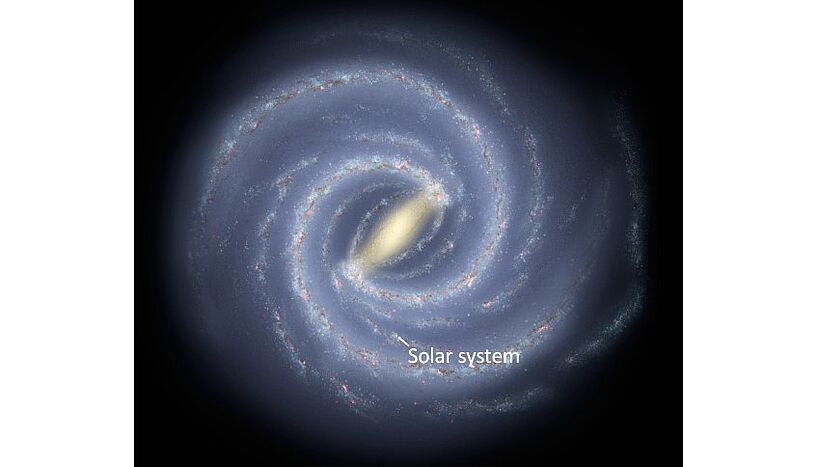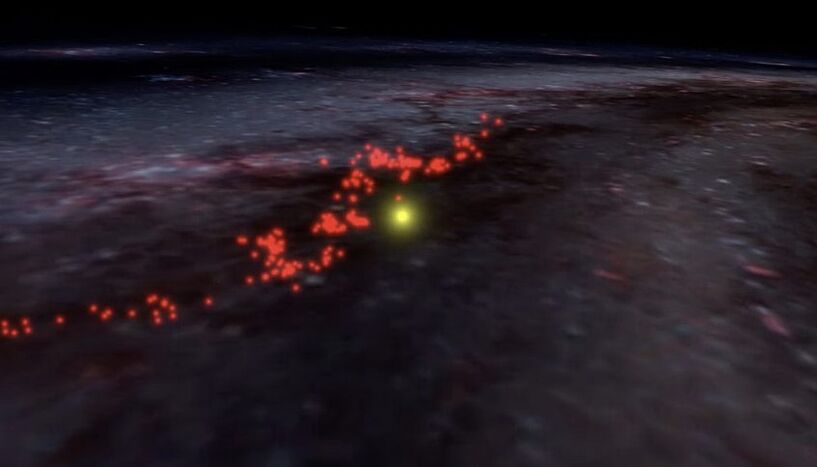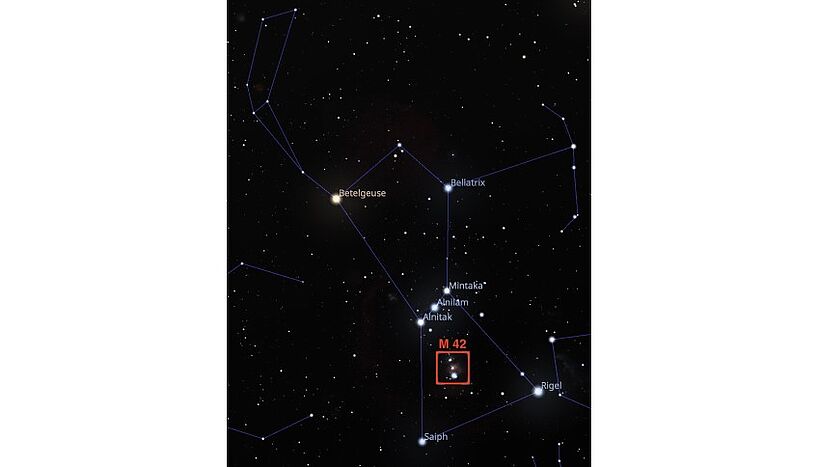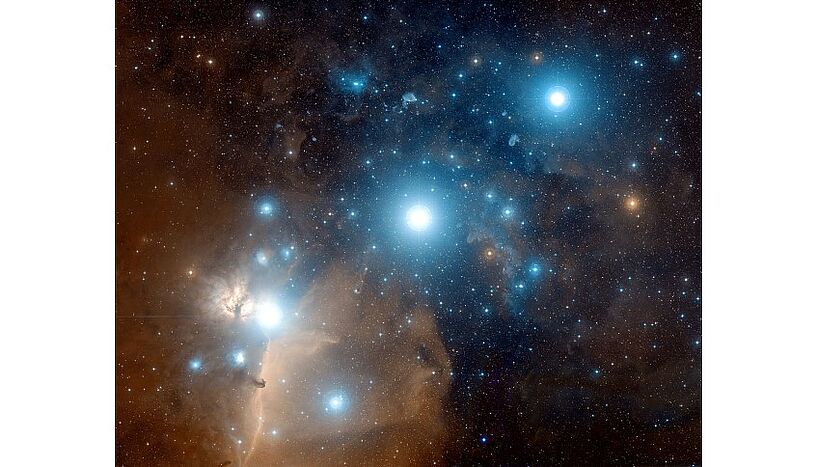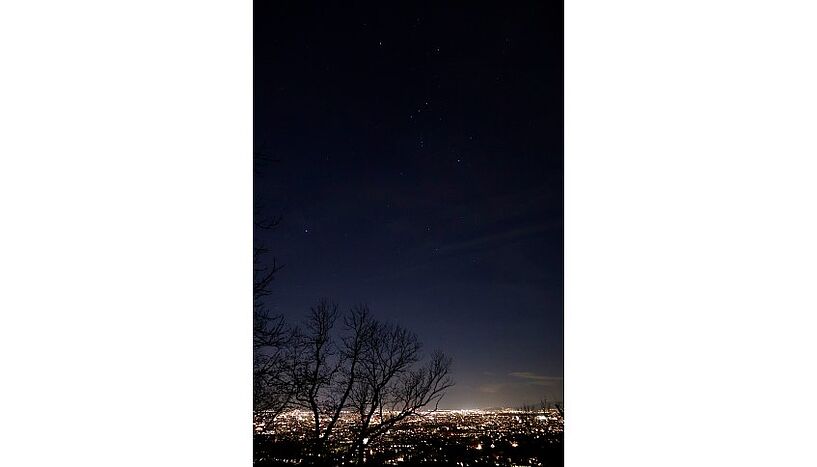The Galactic Journey of our Solar System
25. February 2025Our sun and its planets crossed the Radcliffe Wave in the well-known Orion complex
An international research team led by the University of Vienna has discovered that the Solar System traversed the Orion star-forming complex, a component of the Radcliffe Wave galactic structure, approximately 14 million years ago. This journey through a dense region of space could have compressed the heliosphere, the protective bubble surrounding our solar system, and increased the influx of interstellar dust, potentially influencing Earth's climate and leaving traces in geological records. The findings, published in Astronomy & Astrophysics, offer a fascinating interdisciplinary link between astrophysics, paleoclimatology, and geology.
The Solar System's journey around the Milky Way's center takes it through varying galactic environments. "Imagine it like a ship sailing through varying conditions at sea," explains Efrem Maconi, lead author and doctoral student at the University of Vienna. "Our Sun encountered a region of higher gas density as it passed through the Radcliffe Wave in the Orion constellation."
Using data from the European Space Agency's (ESA) Gaia mission and spectroscopic observations, the team pinpointed the Solar System's passage through the Radcliffe Wave in the Orion region about 14 million years ago. "This discovery builds upon our previous work identifying the Radcliffe Wave," says João Alves, professor of astrophysics at the University of Vienna and co-author of the study. The Radcliffe Wave is a vast, thin structure of interconnected star-forming regions, including the renowned Orion complex, which the Sun traversed, as established in this study.
"We passed through the Orion region as well-known star clusters like NGC 1977, NGC 1980, and NGC 1981 were forming," Alves notes. "This region is easily visible in the winter sky in the Northern Hemisphere and summer in the Southern Hemisphere. Look for the Orion constellation and the Orion Nebula (Messier 42)—our solar system came from that direction!"
The increased dust from this galactic encounter could have had several effects. It may have penetrated the Earth's atmosphere, potentially leaving traces of radioactive elements from supernovae in geological records. "While current technology may not be sensitive enough to detect these traces, future detectors could make it possible," Alves suggests.
The team's research indicates the Solar System's passage through the Orion region occurred between approximately 18.2 and 11.5 million years ago, with the most likely time between 14.8 and 12.4 million years ago. This timeframe aligns well with the Middle Miocene Climate Transition, a significant shift from a warm variable climate to a cooler climate, leading to the establishment of a continental-scale prototype Antarctic ice sheet configuration. While the study raises the possibility of a link between the past traverse of the solar system through its galactic neighborhood and Earth’s climate via interstellar dust, the authors emphasize that a causal connection requires further investigation.
Not comparable to the current human-made climate Change
"While the underlying processes responsible for the Middle Miocene Climate Transition are not entirely identified, the available reconstructions suggest that a long-term decrease in the atmospheric greenhouse gas carbon dioxide concentration is the most likely explanation, although large uncertainties exist. However, our study highlights that interstellar dust related to the crossing of the Radcliffe Wave might have impacted Earth’s climate and potentially played a role during this climate transition. To alter the Earth’s climate the amount of extraterrestrial dust on Earth would need to be much bigger than what the data so far suggest," says Maconi. "Future research will explore the significance of this contribution. It’s crucial to note that this past climate transition and current climate change are not comparable since the Middle Miocene Climate Transition unfolded over timescales of several hundred thousand years. In contrast, the current global warming evolution is happening at an unprecedented rate over decades to centuries due to human activity."
This study is important because it adds a small puzzle piece to the recent history of the Solar System, helping to place it in the context of the Milky Way. "We are inhabitants of the Milky Way," says Alves, "The European Space Agency’s Gaia Mission has given us the means to trace our recent route in the Milky Way’s interstellar sea, allowing astronomers to compare notes with geologists and paleoclimatologists. It’s very exciting." In the future, the team led by João Alves plans to study in more detail the Galactic environment encountered by the Sun while sailing through our Galaxy.
Original publication:
Maconi, E., J. Alves, C. Swiggum, S. Ratzenböck, J. Großschedl, P. Köhler, N. Miret-Roig, et al. "The Solar System’s Passage through the Radcliffe Wave during the Middle Miocene." Astronomy & Astrophysics 694 (February 11, 2025): A167.
DOI: 10.1051/0004-6361/202452061.
Material:
VIDEO: This is a 3D visualization of the Orion Nebula and it is based on the Hubble Space Telescope observations. © NASA, ESA, and F. Summers, G. Bacon, Z. Levay, J. DePasquale, L. Hustak, L. Frattare, M. Robberto, M. Gennaro (STScI), R. Hurt (Caltech/IPAC), M. Kornmesser (ESA)
Featured in the original publication: Interactive 3D visualization of the Sun’s orbit (yellow), selected clusters (blue), and their parental clouds (gray) over the past 30 Myr (more details are provided within the paper). The Radcliffe wave model (light red) is shown in the present-day view.
Figures:
Fig.1: Artistic representation of the Milky Way. The position of the Solar System is pointed by a white row. C: NASA/JPL-Caltech/ESO/R. Hurt
Fig. 2: The Radcliffe wave. The clouds that comprise this structure are highlighted in red and superimposed on an artist's illustration of the Milky Way. The location of the Sun is highlighted by the yellow dot. C: Alyssa A. Goodman/Harvard University
Fig. 3: The Orion constellation. The main stars of this constellation are connected by straight blue lines and some of them are labelled by their name. The Orion Nebula (M 42) is identified by the red square. The image is a screenshot from Stellarium, a free and open-source planetarium. C: Created by Stellarium (GNU), Edited by Efrem Maconi
Fig. 4: The Orion belt. C: Davide De Martin & the ESA/ESO/NASA Photoshop FITS Liberator
Fig. 5: Orion over Vienna. C: Efrem Maconi
Scientific contact
Dott. Dott. mag. Efrem Maconi
Institut für AstrophysikUniversität Wien
1180 - Wien, Türkenschanzstraße 17 (Sternwarte)
efrem.maconi@univie.ac.at
Univ.-Prof. Dr. João Alves
Fakultät für Geowissenschaften, Geographie und AstronomieUniversität Wien
1090 - Wien, Althanstraße 14
+43-1-4277-53810
joao.alves@univie.ac.at
Further inquiry
Theresa Bittermann
Media Relations, Universität Wien1010 - Wien, Universitätsring 1
+43-1-4277-17541
theresa.bittermann@univie.ac.at
Downloads:
202502_Alves_Fig1_01.jpeg
File size: 3,22 MB
202502_Alves_Fig2_01.jpeg
File size: 2,4 MB
202502_Alves_Fig3_01.jpeg
File size: 1,24 MB
202502_Alves_Fig4_01.jpeg
File size: 396,2 KB
202502_Alves_Fig5_01.jpeg
File size: 3,81 MB

